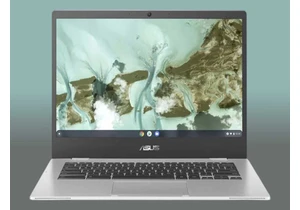Expert's Rating
Pros
- Immersive contrast
- Very wide, vivid color gamut
- Appealing motion clarity at 175Hz
Cons
- Generic look and feel
- Color accuracy is a tad behind competitors
- Doesn’t stand out from QD-OLED alternatives
Our Verdict
The Gigabyte MO34WQC is a generically great QD-OLED display. Unfortunately, opting for its dull design doesn’t save you any cash.
Shoppers looking to buy a 34-inch ultrawide OLED monitor have no shortage of options this summer, and that means the details matter. Gigabyte’s MO34WQC has an OLED panel with image quality and motion clarity typical of the competition, but tries to stand out with additional USB-C and USB connectivity. While this does improve its appeal, your decision is likely to be based on its price.
Gigabyte MO34WQC specs and features
The Gigabyte MO34WQC has a Samsung QD-OLED panel with a resolution of 3440×1440 and a refresh rate of up to 175Hz. This is similar to most QD-OLED monitors on the market, but behind the latest panels, which can hit 240Hz or higher.
Gigabyte offers an alternative model, the MO34WQC2, which has a QD-OLED panel with a higher maximum refresh rate of 240Hz. It’s also more expensive with a typical retail price of $1,000. The two monitors are similar enough that Gigabyte issued the same user manual for both, but we haven’t tested the MO34WQC2 yet.
- Display size: 34-inch ultrawide 21:9 aspect ratio
- Native resolution: 3440×1440
- Panel type: Anti-reflection QD-OLED
- Refresh rate: Up to 175Hz
- Adaptive sync: Adaptive Sync, AMD FreeSync Premium Pro
- Ports: 2x HDMI 2.1, 1x DisplayPort 1.4, 1x USB-C with DisplayPort Alternate Mode and 18 watts USB Power Delivery, 2x USB-A 3.2 downstream, 1x USB-B 3.2 upstream, 1x 3.5mm headphone jack, 1x 3.5mm microphone jack
- VESA mount: 100x100mm
- Speakers: Yes, 2x 3-watt speaker system
- Price: $949.99 MSRP, $849.99 typical retail
Panel aside, the MO34WQC’s specifications have a few highlights. The monitor features two HDMI 2.1 ports, in addition to DisplayPort and a USB-C port with DisplayPort support, for a total of four video inputs. The USB-C port also provides power, though not enough to charge a PC laptop quickly. Built-in speakers are included as well, which isn’t true of all competitors.
Further reading: See our roundup of the best monitors to learn about competing products.
Gigabyte MO34WQC design
The Gigabyte MO34WQC is sold as a gaming monitor but it’s not part of Gigabyte’s Aorus gaming sub-brand, so it delivers a more basic, workmanlike design. The front of the panel boasts slim black bezels on three sides and a small plastic chin at the bottom, while the rear of the panel is coated in black plastic that feels sturdy but looks unremarkable. The MO34WQC strikes a much more generic profile than design leaders like the Alienware AW3423DWF or Samsung Odyssey G85SB.
Gigabyte ships the monitor with an ergonomic stand that adjusts for height, tilt, and swivel. The stand has a wide base that takes up a fair bit of room on a desk, but the base is flat and not too thick, so it’s possible to place items on the space it occupies. The stand also feels sturdy and proves easy to adjust with modest effort. A 100x100mm VESA mount is available for use with a third-party monitor arm, stand, or wall mount.
The monitor is curved with a radius of 1800R, meaning the display panel would need to continue for 1,800 millimeters (about 6 feet) to form a full circle. The curve is noticeable but doesn’t draw too much attention, and most 34-inch QD-OLED monitors have settled on 1800R as the preferred curve radius for this size of monitor.
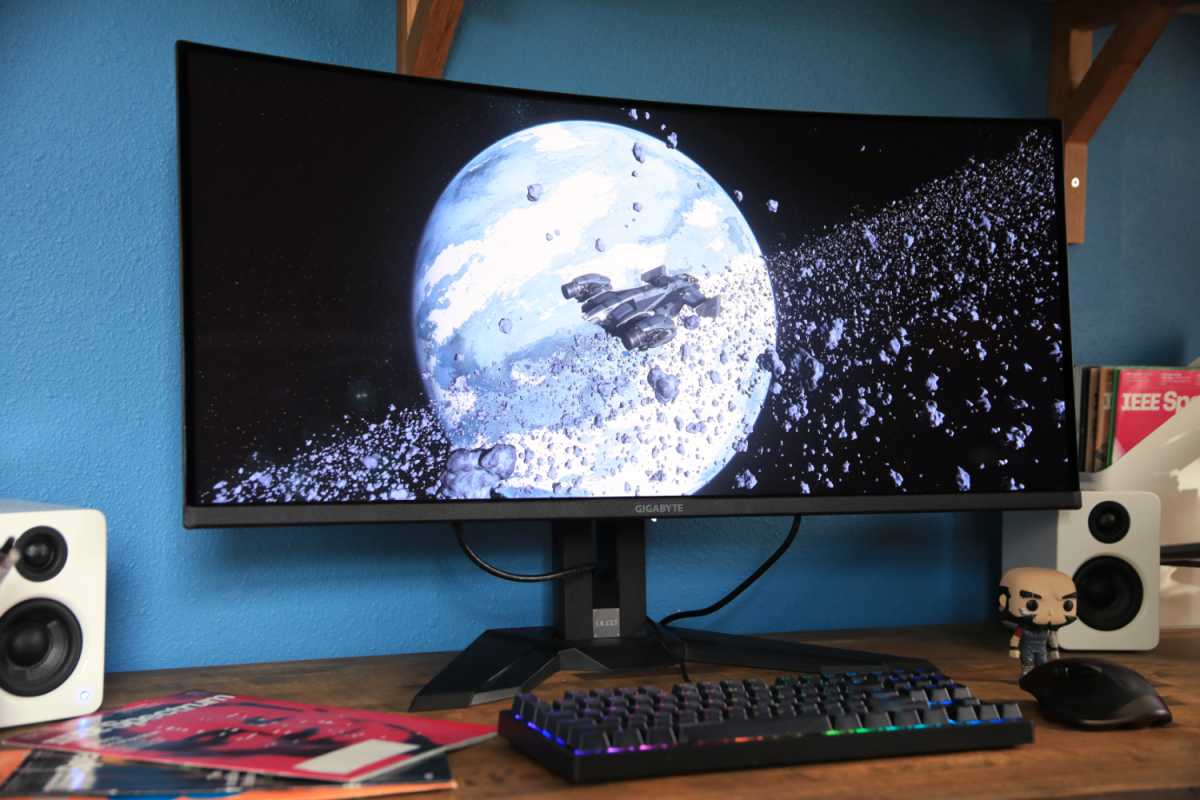
Matthew Smith / Foundry
Matthew Smith / Foundry
<div class="scrim" style="background-color: #fff" aria-hidden="true"></div>
</div></figure><p class="imageCredit">Matthew Smith / Foundry</p></div>Gigabyte MO34WQC design connectivity and menus
Gigabyte provides a total of four video inputs for the MO34WQC: two HDMI 2.1 ports, one DisplayPort 1.4 port, and a USB-C port, which also supports DisplayPort mode. While four video inputs are not unusual for a monitor in this price range, they do cover most use cases, and all available ports support the display’s maximum refresh rate.
The monitor also has two USB-A downstream ports, which can be driven either by the USB-C port or, if your PC lacks USB-C, through a USB-A to USB-B connection. Gigabyte includes a KVM switch function, allowing you to use the monitor as a KVM switch if you connect your wired keyboard and mouse to the monitor. The USB-C port has Power Delivery, but only up to 18 watts, which means it’s not a good choice for powering and charging a laptop with USB-C.
Gigabyte provides an intuitive and responsive joystick to control the on-screen menus. The menus themselves are large and well-organized but, despite their size, the font is still thin and a bit difficult to read. Gigabyte offers a good range of image quality options, including multiple color temperature, gamma presets, and six-axis color calibration — but that’s typical at this price point.
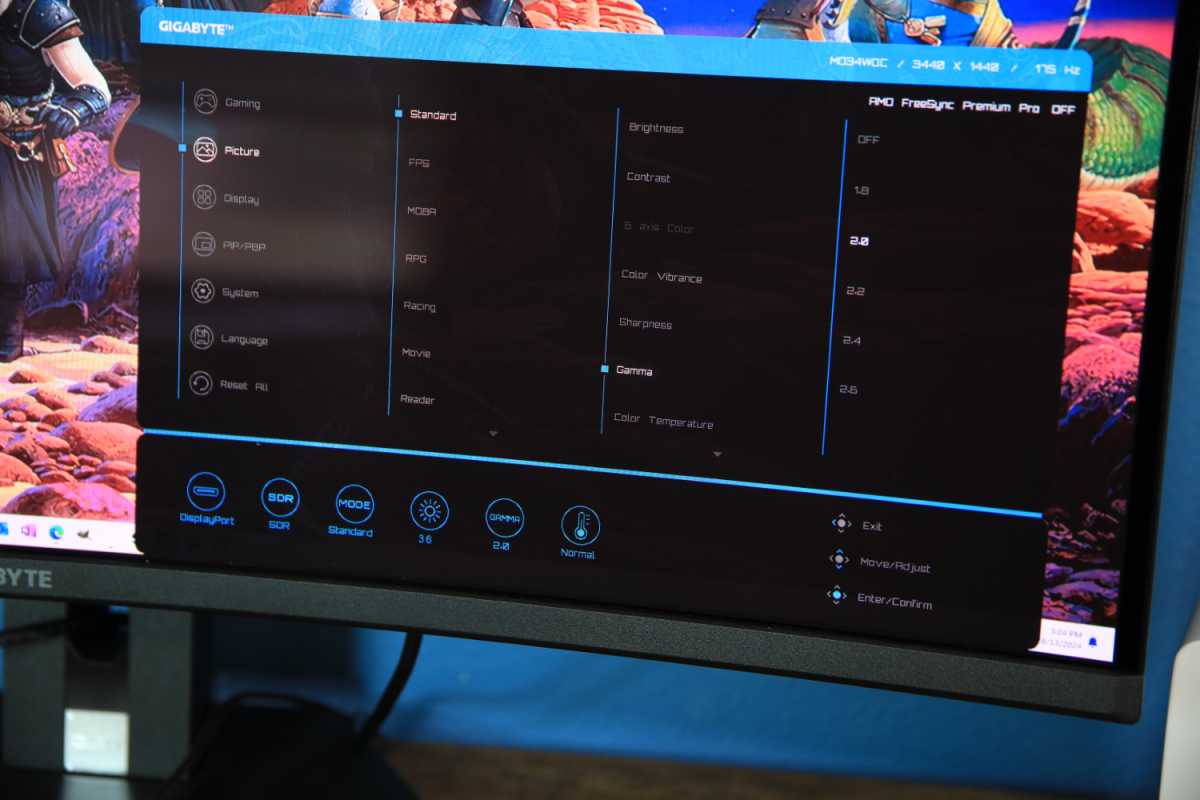
Matthew Smith / Foundry
<div class="lightbox-image-container foundry-lightbox"><div class="extendedBlock-wrapper block-coreImage undefined"><figure class="wp-block-image size-large enlarged-image"><img decoding="async" data-wp-bind--src="selectors.core.image.enlargedImgSrc" data-wp-style--object-fit="selectors.core.image.lightboxObjectFit" src="" alt="gigabyte mo34wqc menu" class="wp-image-2427868" width="1200" height="800" loading="lazy" /></figure><p class="imageCredit">Matthew Smith / Foundry</p></div> </div></figure><p class="imageCredit">Matthew Smith / Foundry</p></div>Also typical is the monitor’s gaming features: It has a black equalizer to elevate the brightness of dark areas in games and some optional on-screen elements like a crosshair. There’s multiple aspect ratio modes, too, which emulate the size of a 24-inch or 22-inch display, as well as a 1:1 aspect ratio mode. Picture-by-picture and picture-in-picture modes are also available.
While the MO34WQC includes built-in speakers, they’re unremarkable. The maximum volume is adequate, and sound quality is clear in basic situations such as listening to podcasts. But games, movies, and other entertainment will quickly overwhelm them, resulting in muddy and unpleasant sound. External speakers or headphones are still recommended for most people.
Gigabyte MO34WQC SDR image quality
At this point, you might be sensing a theme: The Gigabyte MO34WQC is a good QD-OLED monitor, but not one that stands out from the crowd. This continues to be true when it comes to image quality. It’s a fantastic monitor for SDR content, but no more so than its QD-OLED peers.
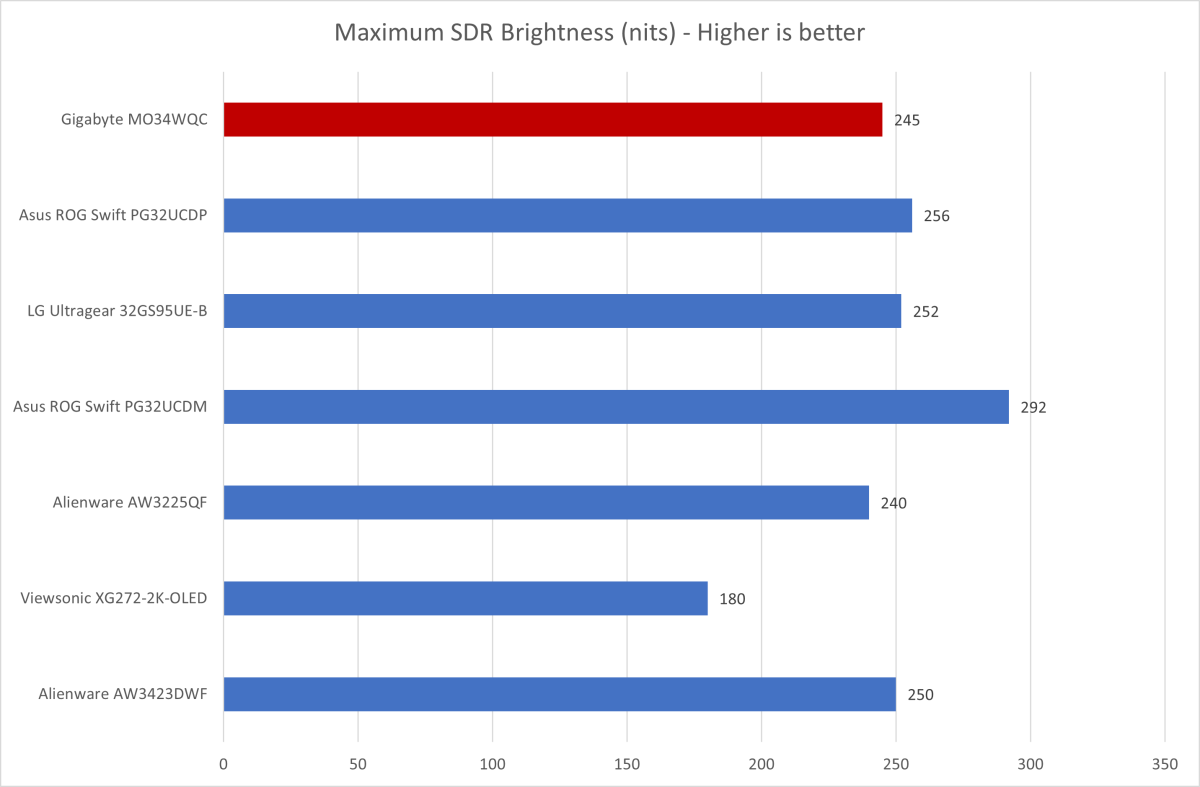
Autentifică-te pentru a adăuga comentarii
Alte posturi din acest grup

Remember back when Windows 11 first came out and Microsoft gave every
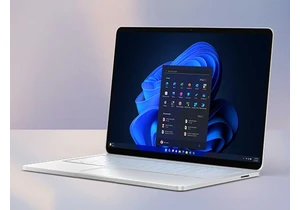

On Friday afternoon, Intel confirmed what everyone already knew: that

I recently moved to a much more rural area, so getting Starlink set u

I review a lot of laptops and I’ve noticed many of them come with a “

TL;DR: Replace your Adobe Acrobat monthly fee with a
